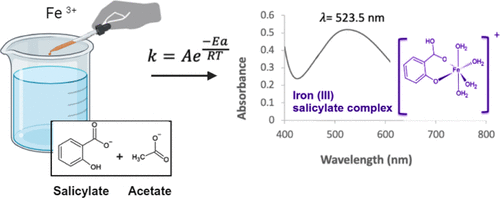A Laboratory Module for Physical Chemistry and Analytical Chemistry: The Kinetics of Aspirin Hydrolysis and Its Quantitation in Pharmaceutical Tablets

In this three-component laboratory module, upper-division chemistry students were introduced to the kinetics of the aspirin hydrolysis reaction and determined the concentration of its active pharmaceutical ingredient (acetylsalicylic acid-ASA) using a modern, benchtop ultraviolet–visible (UV–vis) absorption spectrophotometer. In the first component, students prepared analyte solutions from over-the-counter aspirin tablets and a relevant number of standards (n = 9–10) through both serial and parallel dilutions. In the second component, the ASA concentrations of three over-the-counter formulations (325 mg per tablet) were determined with percent differences as small as 1.1% using the Beer–Lambert law and external calibration curves. In the third component, students evaluated the reaction order (pseudo-first order), the rate constant (e.g., k = 3.0 × 10–4 s–1 at 75°C), and the activation energy (Ea ∼ 67.3 kJ mol–1) of the hydrolysis reaction of ASA at various temperatures (e.g., 25, 37, 50, 75, and 85°C). The last component was completed using a student-centered instructional approach, namely, process-oriented guided-inquiry learning (POGIL), which helped refine students’ research process skills and both basic and in-depth laboratory skills (weighing, solution handling, micropipetting, operation of a pH meter and a modern, benchtop absorption spectrophotometer). The student and instructor evaluations indicated a positive learning experience and high interest in this laboratory that was inspired by the quality control and quality assurance of pharmaceutical drugs.
Reference
Victoire Delattre, Remi Olivier Labeille, Nicholas Slade Shropshire, Kyra Grace Kaiser, Brent Kirkland, Keith Zvoch, Ioana Emilia Pavel, J. Chem. Educ., 2025, 102, 2, 746–753, DOI 10.1021/acs.jchemed.4c00809